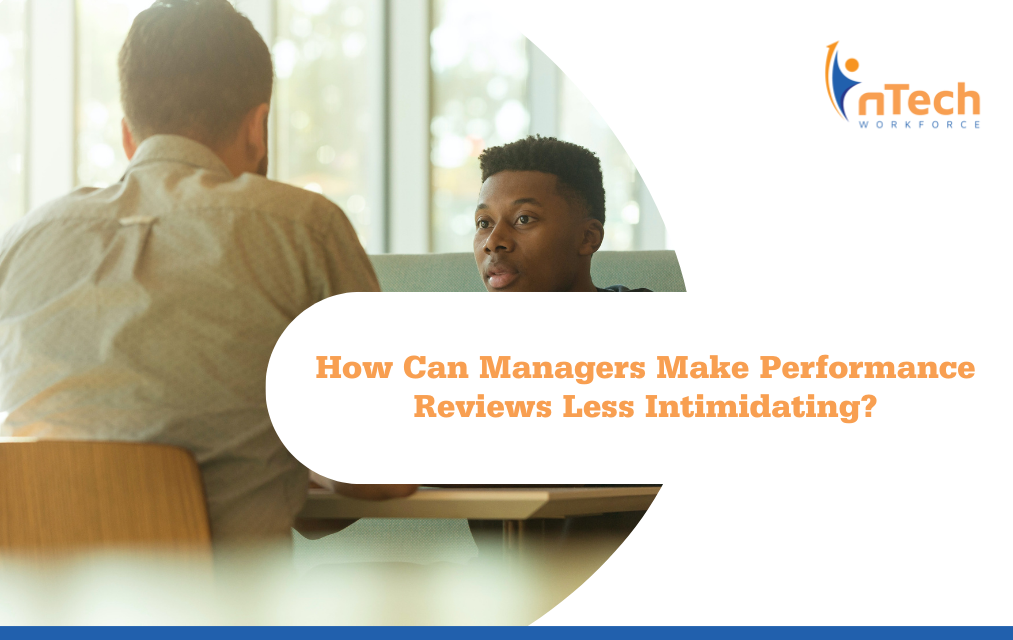How Can Business Leaders Foster Employee Engagement?
According to a Gallup study “Without employee engagement, there’s no team engagement, making it more difficult to improve business outcomes.”
4 min read
![]() nTech Workforce
:
Aug 14, 2023 9:00:00 AM
nTech Workforce
:
Aug 14, 2023 9:00:00 AM

Performance reviews are often dreaded conversations for both employees and management, but the good news is that they don't have to be.
Today, many companies are doing away with the traditional performance review process, and opting instead to provide performance feedback and goal-setting conversations on an ongoing basis.
In this edition of nSider, Elisa Burgos-Ojeda, Learning and Development Manager at nTech Workforce, shares why performance evaluations have such a bad rep and why ongoing performance feedback and goal setting might be the better option.
Performance reviews typically strike fear into the hearts and minds of most people. According to Burgos-Ojeda, “They’re intimidating because they’re rare and they’re inefficient.”
Traditional performance reviews are typically overly formal and infrequent to the point that some of the feedback may not even be pertinent, or it would have been more helpful to have that feedback sooner. If the goal is to have a helpful chat about how employees have excelled or how they can improve, then why do they tend to be so intimidating?
Burgos-Ojeda explains that they “happen once a year where both the manager and the individual contributor have to comb through all of the milestones and goals and outputs and performance of the previous year, and they have to have a conversation about it that might not have taken place in any form throughout the entire year, and that’s very stressful.”
According to Staffcircle, the traditional performance review process goes against emerging insights that more periodic, ongoing, casual review conversations can be much more accurate and effective.
Bias can factor heavily into performance reviews without anyone even being aware. Recency bias, or the tendency to overemphasize recent memories and downplay less recent ones, can be a big factor in a performance review. “If you had a recent success, the conversation would go well,” reports Burgos-Ojeda, even if you had a string of failures earlier in the year, and the opposite also tends to be true.
There are several reasons why the standard formula for performance reviews is not effective. “The goal is that you have communication set up effectively throughout the year,” Burgos-Ojeda says, “so that the performance reviews, no matter the cadence in which they happen, are like a check-in.”
The practice of annual performance reviews has been waning for decades, with many organizations opting to do away with them completely. But no communication or feedback between management and individual staff is not ideal, so luckily, there are more effective approaches.
Ultimately, every company or department should try to find a review rhythm that works for them. “It depends on the resources that they have and the communication they’re maintaining over time,” says Burgos-Ojeda, “the important thing is to make sure that you have regular one-on-one meetings between the manager and employee. Doing this all year long, allows you to have performance conversations about issues as they arise in real time so you can resolve them together
"Developing feedback skills is so important in the workplace, and those skills will serve you well both within more formal reviews and in the context of day-to-day work," says Burgos-Ojeda. "Whether your company provides performance reviews as quarterly check-ins, half-year reviews, or yearly reviews, the first step is to be sure that the feedback is specific to the employee's work, not their personality. Which outcomes and behaviors have been effective, and which could use improvement? Positive feedback is just as important if not more so than negative feedback, because identifying and encouraging effective ways of working keeps people going. We can often default to only recognizing the problems that need fixing, and it's important to recognize what does work, and where improvement has been shown. Remember to keep performance feedback relevant to the employee's job responsibilities and competencies, specific, clear, growth-oriented, and actionable."
Once you have determined what feedback to offer, it's time to think about how to communicate it effectively so that the employee will understand and benefit from it.
Whether it's positive or constructive, one formula that can be very effective in delivering feedback is to use a 'Behavior, Impact, Question' framework. You can sum this up as three main points: What is the specific behavior--focusing on data, not your interpretation, feelings, or assumptions--that you want to discuss? What is the impact of the behavior--why does it matter, who is impacted by it, and how? Once this feedback has been provided, you can move on to a question such as "How do you see it?" or "What can we do to avoid this in the future?" The goal is to end the feedback with a clear action plan to address the issue going forward. (Burgos-Ojeda)
One of the best ways to offer constructive feedback is to do it when it happens rather than wait for a performance review or check-in. Burgos-Ojeda recommends approaching the conversation by asking questions like, “What happened? What came up for you? What can we do to avoid this happening in the future?”
Reflecting on the answers you receive might provide the key to finding solutions. Burgos-Ojeda adds, “Maybe that means the structure of the work needs some sort of modification. Or perhaps it means that the employee needs to approach it differently.”
When issues are addressed in real time, they don’t have to become ongoing problems. They can be resolved quickly. Sometimes employees aren’t aware their performance is sub-optimal, and other times they need extra support but don’t know how to ask for it.
Making space for these conversations can solve these challenges quickly and also aid in improving relationships so employees feel more comfortable and empowered to come forward with future challenges.
Performance feedback can have a major effect on workers, for better or worse, so managers need to prepare ahead of time for a good conversation. That preparation could also involve some extra learning on the part of the reviewer as well.
“I highly recommend that no one does any kind of performance feedback without receiving some training on bias mitigation,” says Burgos-Ojeda, as this will help to “yield a richer, more beneficial conversation for both parties.”
If you’re interested in learning more about staff management, or ways that you can build trust with your teams, nTech Workforce can help. We specialize in building winning teams and finding the right people. Contact a team member today to learn more.

According to a Gallup study “Without employee engagement, there’s no team engagement, making it more difficult to improve business outcomes.”

Staffing agencies are motivated to provide clients with the best advice around not just recruiting but also retaining top talent.

In the realm of leadership, the ability to build trust through effective communication is a fundamental skill. How is trust defined in the context of...